NEW: Find Empty iTunes Media Folders
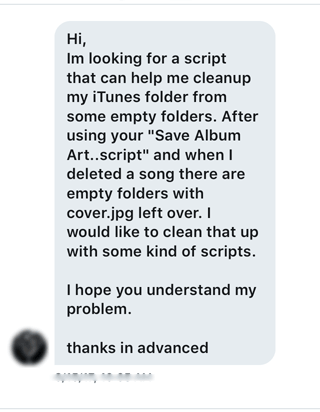
A tweet is worth...well, I guess only 140 characters. But a picture of a tweet should be worth more, right?
Anyway, this tweet from a Correspondent reminded me about something I've been aiming to do for a while and that's find the folders in the iTunes Media folder that 1) are empty and that iTunes wouldn't or couldn't delete and 2) find the folders that are virtually empty except for any files that aren't compatible with iTunes.
Typically, if you allow iTunes to manage the iTunes Media folder, iTunes will remove "Artist" and "Album" folders when it happens that they become empty by virtue of deleting tracks and their files in the app. But, if you manage the iTunes Media folder yourself (or some other folder/s that store your media files) and delete tracks and files, I'm not so sure iTunes will delete the empties. Or, if, like the author of the tweet, you've placed files alongside your media that iTunes doesn't recognize—set lists or liner notes as text files, album art as "folder.jpg" or "cover.jpg" files, and so on—then iTunes won't delete these folders either. My guess is that if you've Trashed the media files, you probably don't need the associated bric-a-brac anymore and these folders could be disposed of.
Short of going through the entire iTunes Media folder using your fingers and eyeballs, Find Empty iTunes Media Folders will quickly traverse the iTunes Media folder looking for empty folders and folders that only contain files that iTunes doesn't recognize.
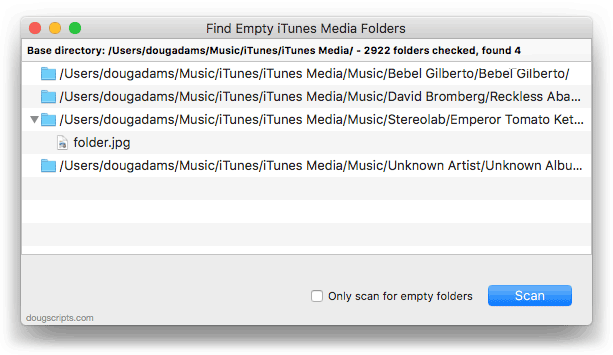
I wish I had taken a screenshot of the folders it found before I really started testing the delete feature. I originally had about thirty folders either empty or containing potential jetsam.
Find Empty iTunes Media Folders can be downloaded and used in Demo Mode for free. In Demo Mode, several features will be disabled, which include:
- Show Finder Information Window
- Reveal in Finder
- Send to Trash
- Select all Empty/non-Empty
- Only Scan for Empty Folders
- Scan other user-selected folder
If you like and use the app, you can purchase a registration code for $1.99 that will remove the Demo Mode restrictions and enable the features listed above. You can get more information and download it from this page.
UPDATED: Merge-Delete Playlists v5.1
Merge-Delete Playlists will allow you to merge the track contents of two or more playlists to a new or existing playlist or delete any number of playlists at once, including Smart, Genius, and Playlist Folder playlists. The merge feature will prevent the same tracks that may appear in different source playlists from being duplicated and has an option to delete original playlists. The delete feature only deletes playlists; tracks, of course, remain in the library.
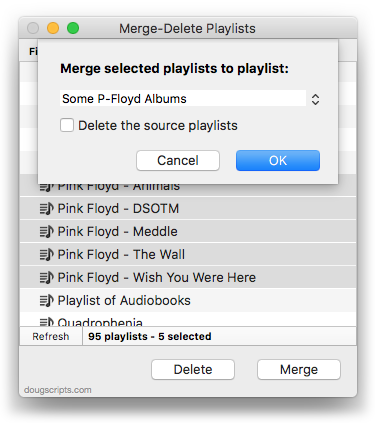
This latest version brings back Apple Music playlists detection; the last version removed this ability because I hadn't worked out all the details on how to handle them properly. They will appear with their names italicized at the top of the list in the window. It also fixes a bug that prevented selecting empty Playlist Folders.
Merge-Delete Playlists is free to use full-featured for ten days, thereafter requiring a registration code which can be purchased in-app for $1.99. It can be downloaded from this page.
NEW: Is Artwork Embedded v1.0
Is Artwork Embedded will examine the single selected track's audio file for image information in its metadata. If "embedded artwork" is found, the script will display something like this (where the image is the actual information retrieved from the metadata):
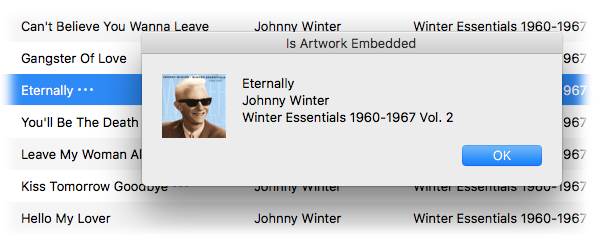
And if it can't detect any artwork metadata:

iTunes doesn't always transfer assigned track artwork to a file's metadata, although most purchased tracks and downloads will have it. Also, just because an audio file's Finder icon displays album artwork doesn't mean that that artwork is part of the file's metadata:
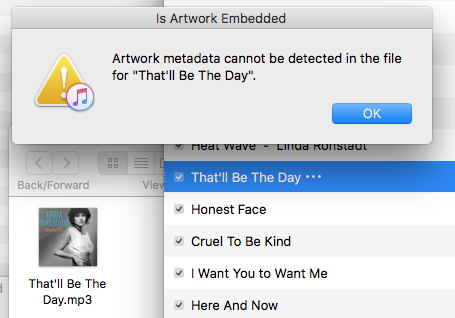
There may also be cases whereby some odd file has embedded artwork that is undetectable by the script (I suppose). But, generally: the script will always be right if it finds artwork metadata (because it displays it), but if it doesn't find artwork it could be wrong.
This script is free to use and is available to download from this page. Lordy, I hope you assign it a keyboard shortcut. I use Option-Command-I.
UPDATED: Delete Empty Playlists v3.0
I have just updated Delete Empty Playlists to v3.0. The previous version would simply delete any empty playlists it found. But I frequently found that I wanted to keep a few, especially if they were Smart playlists with criteria that would just be a pain to re-create.
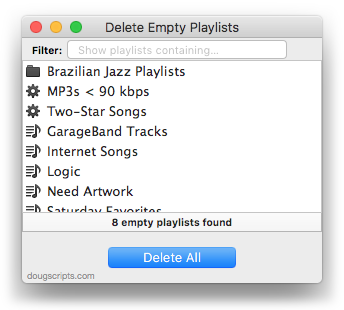
This latest version can, certainly, delete all the empty playlists it finds. But it can also delete just the ones that are selected in the list. Additionally, specific playlists can be isolated by filtering for specific text in their names.
Delete Empty Playlists is free to use with a donation nag and is available to download from this page.
iTunes 12.6.1 Updated
Apple released iTunes 12.6.1.25 just about a week ago. Now build version 12.6.1.27 is available from the App Store app's Updates pane.
I believe this is the third time a release has been updated with a minor build shortly after its initial release.
Unable to Donate
It is possible that a recent change in the operating system may affect the ability to make an in-app donation in several scripts. These will be scripts that have the "nag" screens; when quitting, you may be unable to access PayPal when clicking the "I'll Donate" button. Instead, the script will simply quit.
I am working on updates. Thanks for your patience.
UPDATED: Convert and Replace v2.4
Convert and Replace v2.4 will convert the files of the selected tracks using an iTunes encoder chosen on-the-fly (each encoder's current Preferences-set options will be in effect) and replace the original tracks throughout the playlists of your entire library with the newly converted versions. Additionally, you can opt to Trash/delete or keep the original files and tracks.
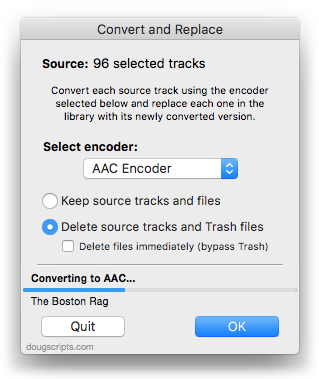
This latest version will stay running and not quit after conversion (registered version), monitors changes to the selection of tracks and removes the ability to select a playlist of tracks.
Interestingly, a Correspondent inquired if the script could be modified to accommodate two conversions. Here's why: he wanted to convert 24 bit depth/48 kHz audio files (downloaded from Bandcamp) to Apple Lossless. But Apple Lossless conversion retains the original bit depth and sample rate, defeating the purpose (to some extent) of converting to a smaller file format. So he uses the script to convert these files to 16 bit/44.1 kHz AIFF files first and then again to convert them to ALAC.
Performing two conversions back-to-back automatically with different encoders would be a bit of a stretch for the script. So, as a compromise, I have let it stay open after conversion (at least for registered users) so that the original set of tracks remains the Source if a second conversion of them is required.
A registration code for Convert and Replace is $1.99 and it's free to demo for ten days; it's a free upgrade for current users. It can be downloaded from this page.
iTunes Folder Missing?
A couple of Correspondents have reported that fresh installations of Sierra do not have a "iTunes" folder in the User Library folder (~/Library/iTunes/). Traditionally, this folder contains the "iTunes Plug-Ins" folder and the "Scripts" folder (see my Download FAQ page for more details). Additionally, some third-party apps may use this folder for caching their own iTunes-related files. However, the "Scripts" folder is not created automatically and needs to be created by the user; and I believe Apple has lately inhibited the use of third-party visualizers such that the "iTunes Plug-Ins" folder may no longer be necessary. Perhaps, therefore, the ~/Library/iTunes/ folder is not created automatically anymore either.
To repeat: this seems to affect clean installs of the latest Sierra and iTunes 12.6 and later. If you already have these folders configured on your machine they will not disappear when you upgrade the operating system—at least, that's been my experience.
iTunes still looks for AppleScript files in this location to make them available in its Script menu, so if your system isn't configured with the ~/Library/iTunes/ folder you will have to create the intermediate "iTunes" folder there and then the "Scripts" folder within it.
AppleScripts can also be installed in the /Library/iTunes/Scripts/ folder—that's the [startup disk]/Library/ folder and putting AppleScripts here makes them available to all Users. Again, the "Scripts" folder may have to be created by the user.
AppleScripts will appear in the system-wide Script menu in the Menu Bar when they are installed in ~/Library/Scripts/Applications/iTunes/ for the single User or /Library/Scripts/Applications/iTunes/ for all Users.
Apple Releases iTunes 12.6.1
Apple has released iTunes 12.6.1 with "minor app and performance improvements". Updates for each operating system were also released today. More as it develops.

 Kirk and I go deep on playlists in iTunes in this week's episode of The Next Track podcast. Real deep.
Kirk and I go deep on playlists in iTunes in this week's episode of The Next Track podcast. Real deep.